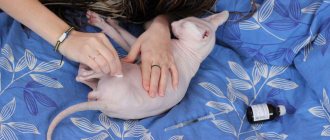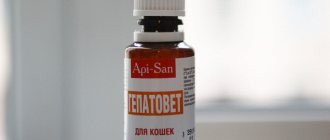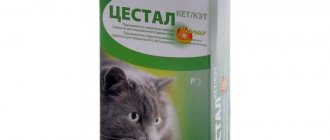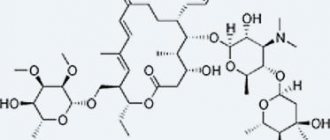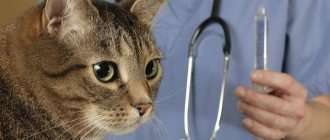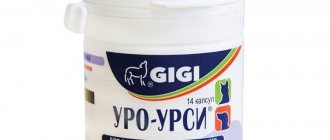Characteristics of the drug Heptral
Heptral belongs to the group of hepatoprotectors, that is, drugs intended to restore liver function. The drug also has an antidepressant effect. The medication promotes the excretion of bile, preventing stagnation. Eliminates the harmful effects of toxins by neutralizing them. The medicine is able to regenerate damaged liver cells, due to which its structure is restored. In addition, the body has an antioxidant effect, which improves the pet’s condition and makes it more active.
Heptral restores the functional activity of liver cells
The drug prevents fibrosis processes in liver tissue and also prevents damage to neurons. Due to the complex effect, the pet’s body quickly recovers from various diseases of the biliary system. In addition, the condition of the coat and skin improves.
The medication is effective even in cases of serious liver problems in pets. It helps eliminate pain and improve digestion.
Composition and release form
The medicine is available in the form of tablets and lyophilisate. The active component for both varieties is ademetionine 1,4-butane disulfonate. Additionally, the tablets include:
- colloidal silicon dioxide;
- microcrystalline cellulose;
- sodium carboxymethyl starch (type A);
- magnesium stearate.
The lyophilisate also contains:
- L-lysine;
- sodium hydroxide;
- d/i water
Heptral is also available in the form of a lyophilisate
The active component is excreted through the kidneys along with urine, which should be taken into account before starting treatment if the pet suffers from severe damage to the urinary system.
Impact on the body
Heptral is valued by veterinarians because it has a positive effect on the body of cats both at the beginning of the development of the disease and in advanced cases, bringing hopeless animals back to life.
The drug has the following properties:
- holistic, promoting the restoration of bile ducts;
- cholekinetic, stimulating the release of bile from the gallbladder;
- antioxidant, activating the removal of harmful substances from the liver;
- regenerating;
- accelerating metabolic processes.
Under the influence of the drug, biochemical reactions proceed more productively, the production of S-adenosyl and L-methionine improves.
When is the drug prescribed to cats?
The medication is prescribed to pets most often for inflammatory diseases of the liver and gall bladder, such as hepatitis and cholecystitis. This product prevents the formation of stones. The medicine is also effective for congestion in the gallbladder, which can be caused by improper feeding or congenital abnormalities of organ development. The drug is used for malignant tumors and fatty liver. This remedy can be used for a number of viral diseases.
Heptral helps cats recover faster from a number of liver diseases
The medication improves the condition of the liver in cases of severe impairment of its functions, restoring the integrity of damaged cells.
Side effects
When using the drug "Gordox", the following side effects may occasionally occur:
- allergy;
- tachycardia;
- thrombophlebitis (with long-term use);
- renal failure;
- vomiting - happens when the drug is administered too quickly;
- psychosomatic reactions, confused perceptions and hallucinations are rare.
Required dosage and drug interactions
The dosage of tablets and solution depends on the weight of the animal. However, the exact amount of the drug should be discussed with your doctor. If the cat has a body weight of up to 2 kg, then the daily dosage should be about two tablets, which should be given in 2 divided doses. The amount of solution in this case is 0.3 - 0.5 ml.
If the pet weighs from 2 to 3 kg, then the dosage should be 3 tablets per day. The amount of solution for such animals varies from 0.5 to 0.7 ml. For a large cat (5 kg or more) 4 tablets per day are provided. The solution should be used in a dose of 0.9 ml. The course of treatment varies from several weeks to 1 month.
The tablets can be mixed with food or given to the cat by force after first crushing and dissolving with a small amount of water. This can be done either using a miniature syringe without a needle or using a teaspoon. The main thing is to hold the pet properly so that it does not break free and the medicine does not accidentally spill.
It is most convenient to use insulin syringes without a needle to give your pet a pill.
An ampoule with a solvent must first be poured into the lyophilisate. Then shake and apply intramuscularly. In this case, it is most convenient to make the injection in the thigh area. To do this, you need to first feel the muscle; it should roll under your finger. Then insert the needle 1 cm at a right angle and very slowly press on the syringe plunger. It is not necessary to disinfect the injection site.
The easiest way to inject a cat in the thigh is
When treating with Heptral, it is advisable not to give your pet any more medications unless the doctor recommends otherwise. The drug does not combine well with plant extracts and hormonal agents, including glucocorticosteroids.
Attention! It is not recommended to choose the form of the drug yourself. What to use in a particular case: lyophilisate or tablets, only the doctor decides.
How to give an injection to a cat and avoid mistakes - video
Kontrikal for children - application features
Contrical can even be used for
. However, this should be done strictly according to indications, without trying to “overdo it” by giving the child a serious medicine for prevention and self-soothing. The dosage of Contrikal for children whose body weight is less than 50 kg is calculated by weight. In this case, they use the formula: 14,000 ATRE per 1 kg of body weight.
However, today the problem of rational use of Kontrikal is quite acute, especially in maternity hospitals in some regions of the country. The fact is that the drug is often prescribed to children with regurgitation syndrome. Moreover, even if there are no brown streaks in the regurgitated masses (a sign of bleeding), but only bile impurities.
In this case, there is a common functional childhood syndrome called “gastroesophageal reflux without bleeding.” Many children suffer from this functional disorder, which usually goes away on its own by the age of six months. And regurgitation syndrome is caused by weakness of the sphincter, which separates the stomach from the esophagus.
As the child develops and muscle tone appears, this syndrome disappears without a trace. In this case, “hedging” is the unjustified use of a drug to treat a condition that is not an indication for its use. Unfortunately, such unjustified use of drugs in children often leads to toxic hepatitis and cirrhosis of the liver.
Speaking about regurgitation syndrome, it should be said that this condition is quite widespread, especially among children born prematurely. However, the internationally accepted and recommended treatment for this syndrome (according to Nelson's guidelines) is not simple. You will have to do a lot of manipulations that require attention and physical effort, and not be limited to a dropper.
So, to eliminate regurgitation syndrome, the baby should be placed in such a way that his head is about 30o higher than his legs. For feeding, it is necessary to choose relatively thick mixtures. After feedings, use agents that accelerate the movement of the food bolus from the stomach and intestines (for example, Reglan or Cerucal).
It is also advisable to give the child antacids (for example, Almagel, Phosphalugel) or H2-histamine blockers (for example, Zantag or Tagamet). No other medications should be used to treat regurgitation syndrome. However, treatment can last only until the age of 6 months, since after this the child’s muscles become stronger, the sphincter normally retains the contents in the stomach, and the child ceases to suffer from gastroesophageal reflux.
However, a severe course of gastroesophageal reflux is possible in children of the first year of life. In this case, it is necessary to resort to surgery, which is indicated for the development of the following complications of regurgitation syndrome in a child:
- developmental delay;
- recurrent aspiration pneumonia;
- anemia due to bleeding from the esophagus;
- frequent vomiting;
- large hiatal hernia;
- erosions, ulcers or narrowing of the esophagus.
Cautions and Adverse Reactions
The drug has virtually no contraindications, however, if your pet has genetic diseases, then it should be used for treatment with caution. You should not give tablets or inject lyophilisate into an animal if you are intolerant to the active component. The medicine is contraindicated for pregnant and lactating females. Therapy for kittens can only be carried out with the permission of a doctor. The medication can provoke the appearance of such undesirable reactions from the cat’s body, such as:
- nausea and vomiting;
- stomach ache;
- diarrhea;
- digestive disorders;
- dry mouth;
- increased gas formation;
- hepatic colic;
- bleeding from the gastrointestinal tract;
- convulsive conditions;
- joint pain;
- loss of sensation in the limbs;
- sleep disorders;
- difficulty urinating;
- skin rashes and itching.
Sometimes during treatment with Heptral there is a lack of activity in the pet
In rare cases, when treated with tablets and lyophilisate, serious allergic reactions occur, causing swelling of the larynx.
An inflammatory focus may form at the injection site, and in some cases tissue necrosis develops. Occasionally, the drug causes a loss of strength and an increase in body temperature in pets. At the same time, the animal loses its appetite and its condition becomes unsatisfactory. In this case, you need to urgently inform your veterinarian about such undesirable reactions.
A friend has a cat who is overweight. After another study, abnormalities in liver function were revealed, which was due to the presence of extra pounds. The veterinarian recommended a set of medications, including a hepatoprotector. Giving tablets was very inconvenient, since the cat recognized them in the food and refused to eat. A friend crushed the drug and mixed it with water, then injected it with a syringe. Somehow I managed to endure the course of treatment. The liver condition returned to normal, and the cat became more active.
Contraindications
"Heptral" for cats is a relatively safe drug. It has very few contraindications. This medicine should not be used if the animal is allergic to the components of the tablets.
Caution should also be exercised when treating pregnant cats. During pregnancy, many animals experience stagnation of bile in the liver. In these cases, the veterinarian may prescribe Heptral, having previously assessed the possible benefits for the mother and the risk for future kittens. In this case, it is necessary to carefully follow the recommended dosage.
Precautionary measures
What you need to consider when treating a cat with lyophilisate and tablets:
- Do not under any circumstances exceed the dosage of the drug. In addition, it should be remembered that the amount of medicine is determined only by the doctor, depending on the pathology of the liver and biliary tract. The dosages indicated are approximate.
- Do not inject quickly, otherwise intense pain will occur in the muscle. It is also not recommended to inject with a long needle, which can injure the nerve endings.
- Do not use the same syringe for injections and always wear gloves before starting the procedure.
- Always secure your pet properly. The most convenient way to do this is with the help of another person. This is especially important when administering an injection, since if the cat resists, the needle may enter a vessel or nerve ending.
- If seizures occur in your pet, treatment should be stopped immediately.
- To prevent a hematoma from forming at the injection site and an inflammatory infiltrate from occurring, it is necessary to inject each limb in turn.
- Without preliminary diagnosis and clarification of the cause of the disease, it is prohibited to give Heptral to animals.
- During treatment, coordination of movements may be impaired in cats, so it is important to provide your pet with peace and keep an eye on him.
- When treating with the drug, it is important to provide the animal with access to boiled water.
- If the cat’s condition worsens during treatment, then it is necessary to cancel the course and contact a veterinarian.
For injections at home, it is best to give preference to short needles
Heptral should be used with caution when treating elderly and weakened animals, as the risk of negative reactions increases.
What to choose: tablets or injections
When choosing a dosage form, you should rely on your doctor’s recommendations. Most often, veterinarians prescribe injections for cats, as they give a faster effect. This treatment is also good because it does not have a negative effect on the gastrointestinal tract.
Not every cat owner can inject themselves, and not everyone has the opportunity to take their pet to a veterinary hospital. In such cases, the doctor may prescribe Heptral in tablets.
What can replace Heptral - table
| Name | Release form | Active ingredient | Indications | Contraindications | Possible adverse reactions | Can it be used for pregnant females? | Price |
| Hepatovet | Suspension |
|
|
| Allergy | With doctor's permission. | From 265 rub. |
| Hepatolux | Suspension |
|
|
|
| Not advisable. | From 315 rub. |
| Gepasafe | Injection |
|
| Intolerance to silymarin and vitamin E. | Allergy | Carefully. | From 185 rub. |
Drugs with similar effects - photo gallery
Hepasafe also has an antioxidant effect Hepatovet improves liver function in cats Hepatolux contains milk thistle extract
Pharmacological properties of the drug
Pancreatitis is inflammation of the cells of the pancreas. This organ is responsible for the production of digestive enzymes that enter the intestines and insulin, a hormone that enters the blood.
Typically, the disease develops as a result of an excess of fatty foods in the animal’s diet, which is accompanied by excess weight and accumulation of fat in the blood. The cause of the disease may be concomitant diseases such as diabetes mellitus, hyperthyroidism, existing malignant neoplasms, or the use of certain medications.
Pancreatitis is accompanied by frequent repeated vomiting, loss of appetite or complete refusal of food, pain when palpating the abdomen, weakness, dehydration and stool disturbances.
For pancreatitis, a drug is used that reduces the formation of damage to the pancreas as a result of the formation of enzymes during the next exacerbation - Gordox for cats. The instructions for use must be read before using the drug.
The drug has hemostatic, antiproteolytic and antifibrinolytic properties. It is widely used to reduce bleeding caused by high levels of blood clot-dissolving substances during surgery.
Why is the medication "Gordox" needed? Indications for the use of this remedy include diseases of the digestive system. The active component of the drug has antiproteolytic, hemostatic and antifibrinolytic effects. It is effective for diseases of the pancreas. In addition, this medication can significantly reduce the fibrinolytic activity of the blood. It is very often prescribed as a preventive therapy for any type of shock.
